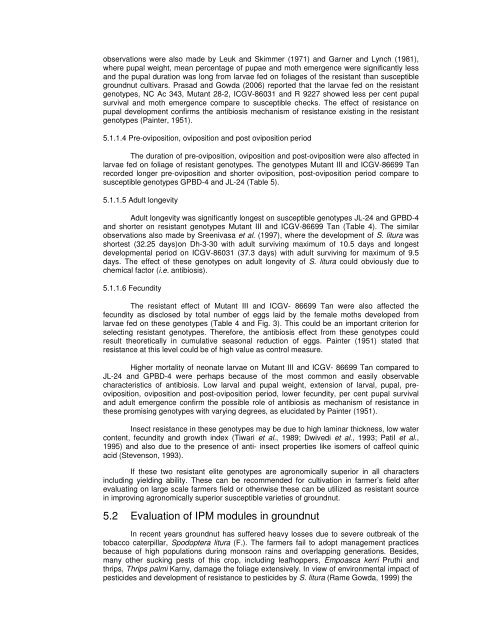screening elite genotypes and ipm of defoliators in groundnut
screening elite genotypes and ipm of defoliators in groundnut
screening elite genotypes and ipm of defoliators in groundnut
You also want an ePaper? Increase the reach of your titles
YUMPU automatically turns print PDFs into web optimized ePapers that Google loves.
observations were also made by Leuk <strong>and</strong> Skimmer (1971) <strong>and</strong> Garner <strong>and</strong> Lynch (1981),<br />
where pupal weight, mean percentage <strong>of</strong> pupae <strong>and</strong> moth emergence were significantly less<br />
<strong>and</strong> the pupal duration was long from larvae fed on foliages <strong>of</strong> the resistant than susceptible<br />
<strong>groundnut</strong> cultivars. Prasad <strong>and</strong> Gowda (2006) reported that the larvae fed on the resistant<br />
<strong>genotypes</strong>, NC Ac 343, Mutant 28-2, ICGV-86031 <strong>and</strong> R 9227 showed less per cent pupal<br />
survival <strong>and</strong> moth emergence compare to susceptible checks. The effect <strong>of</strong> resistance on<br />
pupal development confirms the antibiosis mechanism <strong>of</strong> resistance exist<strong>in</strong>g <strong>in</strong> the resistant<br />
<strong>genotypes</strong> (Pa<strong>in</strong>ter, 1951).<br />
5.1.1.4 Pre-oviposition, oviposition <strong>and</strong> post oviposition period<br />
The duration <strong>of</strong> pre-oviposition, oviposition <strong>and</strong> post-oviposition were also affected <strong>in</strong><br />
larvae fed on foliage <strong>of</strong> resistant <strong>genotypes</strong>. The <strong>genotypes</strong> Mutant III <strong>and</strong> ICGV-86699 Tan<br />
recorded longer pre-oviposition <strong>and</strong> shorter oviposition, post-oviposition period compare to<br />
susceptible <strong>genotypes</strong> GPBD-4 <strong>and</strong> JL-24 (Table 5).<br />
5.1.1.5 Adult longevity<br />
Adult longevity was significantly longest on susceptible <strong>genotypes</strong> JL-24 <strong>and</strong> GPBD-4<br />
<strong>and</strong> shorter on resistant <strong>genotypes</strong> Mutant III <strong>and</strong> ICGV-86699 Tan (Table 4). The similar<br />
observations also made by Sreenivasa et al. (1997), where the development <strong>of</strong> S. litura was<br />
shortest (32.25 days)on Dh-3-30 with adult surviv<strong>in</strong>g maximum <strong>of</strong> 10.5 days <strong>and</strong> longest<br />
developmental period on ICGV-86031 (37.3 days) with adult surviv<strong>in</strong>g for maximum <strong>of</strong> 9.5<br />
days. The effect <strong>of</strong> these <strong>genotypes</strong> on adult longevity <strong>of</strong> S. litura could obviously due to<br />
chemical factor (i.e. antibiosis).<br />
5.1.1.6 Fecundity<br />
The resistant effect <strong>of</strong> Mutant III <strong>and</strong> ICGV- 86699 Tan were also affected the<br />
fecundity as disclosed by total number <strong>of</strong> eggs laid by the female moths developed from<br />
larvae fed on these <strong>genotypes</strong> (Table 4 <strong>and</strong> Fig. 3). This could be an important criterion for<br />
select<strong>in</strong>g resistant <strong>genotypes</strong>. Therefore, the antibiosis effect from these <strong>genotypes</strong> could<br />
result theoretically <strong>in</strong> cumulative seasonal reduction <strong>of</strong> eggs. Pa<strong>in</strong>ter (1951) stated that<br />
resistance at this level could be <strong>of</strong> high value as control measure.<br />
Higher mortality <strong>of</strong> neonate larvae on Mutant III <strong>and</strong> ICGV- 86699 Tan compared to<br />
JL-24 <strong>and</strong> GPBD-4 were perhaps because <strong>of</strong> the most common <strong>and</strong> easily observable<br />
characteristics <strong>of</strong> antibiosis. Low larval <strong>and</strong> pupal weight, extension <strong>of</strong> larval, pupal, preoviposition,<br />
oviposition <strong>and</strong> post-oviposition period, lower fecundity, per cent pupal survival<br />
<strong>and</strong> adult emergence confirm the possible role <strong>of</strong> antibiosis as mechanism <strong>of</strong> resistance <strong>in</strong><br />
these promis<strong>in</strong>g <strong>genotypes</strong> with vary<strong>in</strong>g degrees, as elucidated by Pa<strong>in</strong>ter (1951).<br />
Insect resistance <strong>in</strong> these <strong>genotypes</strong> may be due to high lam<strong>in</strong>ar thickness, low water<br />
content, fecundity <strong>and</strong> growth <strong>in</strong>dex (Tiwari et al., 1989; Dwivedi et al., 1993; Patil et al.,<br />
1995) <strong>and</strong> also due to the presence <strong>of</strong> anti- <strong>in</strong>sect properties like isomers <strong>of</strong> caffeol qu<strong>in</strong>ic<br />
acid (Stevenson, 1993).<br />
If these two resistant <strong>elite</strong> <strong>genotypes</strong> are agronomically superior <strong>in</strong> all characters<br />
<strong>in</strong>clud<strong>in</strong>g yield<strong>in</strong>g ability. These can be recommended for cultivation <strong>in</strong> farmer’s field after<br />
evaluat<strong>in</strong>g on large scale farmers field or otherwise these can be utilized as resistant source<br />
<strong>in</strong> improv<strong>in</strong>g agronomically superior susceptible varieties <strong>of</strong> <strong>groundnut</strong>.<br />
5.2 Evaluation <strong>of</strong> IPM modules <strong>in</strong> <strong>groundnut</strong><br />
In recent years <strong>groundnut</strong> has suffered heavy losses due to severe outbreak <strong>of</strong> the<br />
tobacco caterpillar, Spodoptera litura (F.). The farmers fail to adopt management practices<br />
because <strong>of</strong> high populations dur<strong>in</strong>g monsoon ra<strong>in</strong>s <strong>and</strong> overlapp<strong>in</strong>g generations. Besides,<br />
many other suck<strong>in</strong>g pests <strong>of</strong> this crop, <strong>in</strong>clud<strong>in</strong>g leafhoppers, Empoasca kerri Pruthi <strong>and</strong><br />
thrips, Thrips palmi Karny, damage the foliage extensively. In view <strong>of</strong> environmental impact <strong>of</strong><br />
pesticides <strong>and</strong> development <strong>of</strong> resistance to pesticides by S. litura (Rame Gowda, 1999) the
















